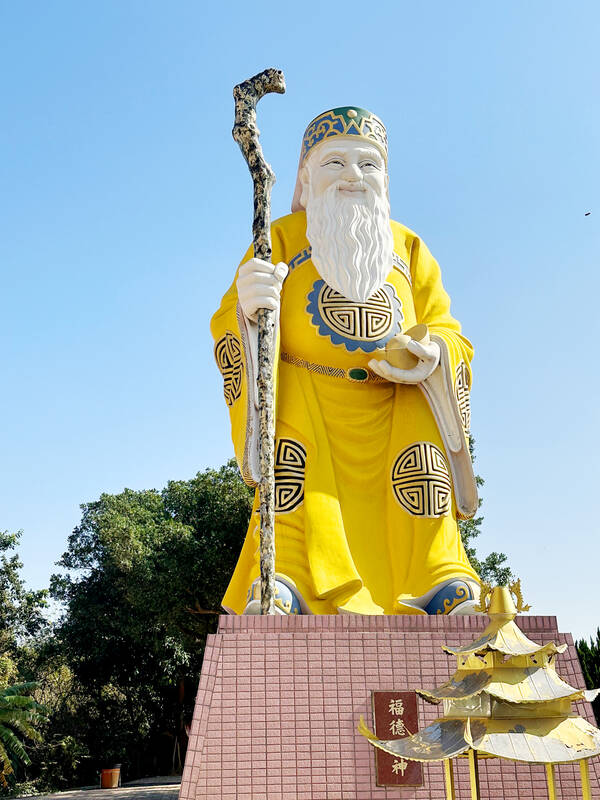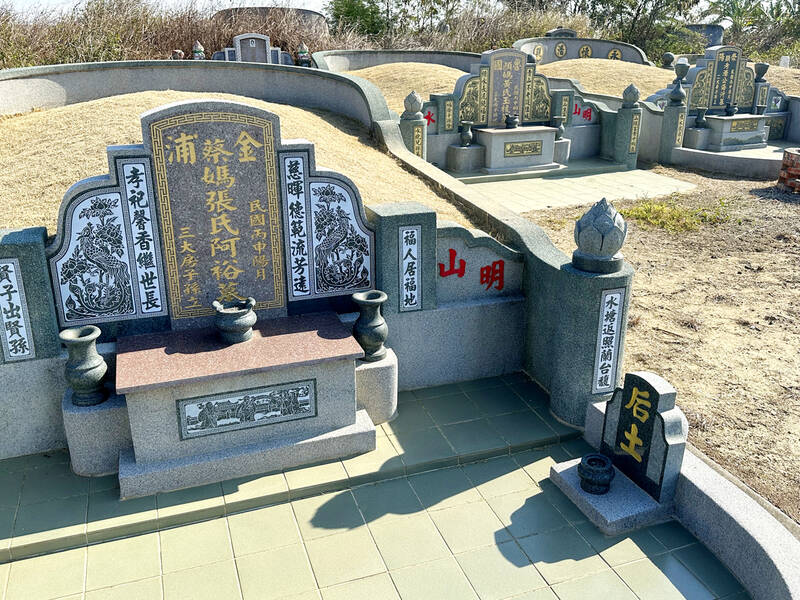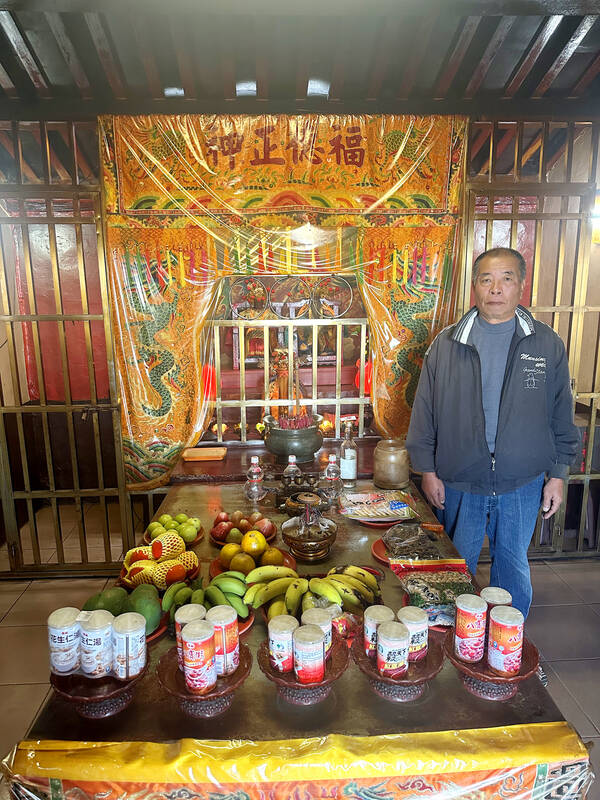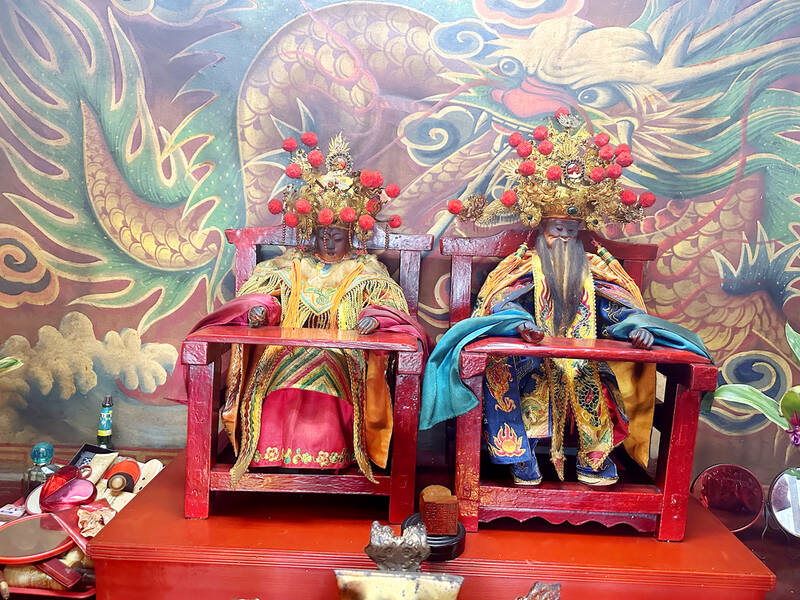My wife awoke one morning with a curious exclamation: “I saw a snake in my dream. I need to go and pray to Tudi Gong.” It turns out there’s a widespread belief that seeing a snake in a dream is a premonition of misfortune. The “dreamer” should worship at the local Tudi Gong temple as soon as possible to avert disaster.
Tudi Gong’s association with snakes reflects his guardianship over the soil (tu) and his protection of a place (di). Although gong is translated as “god,” it’s more useful to think of Tudi Gong as the patron saint of an area.
Tudi Gong is best known perhaps by the roadside shrines, often adjacent to fields, which are distinctive by their diminutive size — some barely waist height and others with the dimensions of a tool shed, but the statues are found everywhere: in households, stores, in almost every Taoist temple as a secondary deity and sometimes in his own temple. Large statues stand guard over columbaria (buildings storing funeral urns) and smaller statues over individual gravestones.

Photo: John Ross
COMMON DEITY
Tudi Gong is the most common deity in Taiwan, yet is very little written about. So, one weekday, I decided to jump on my scooter and explore around my hometown of Puzi in Chiayi County. First stop was local historian Chen Chun-je (陳俊哲), who knows every ruin, rock and tree in the small rural city. He said that Tudi Gong is the spiritual equivalent of a “borough warden,” the guardian responsible for a particular area, taking care of that neighborhood.
He straddles the realms of yin and yang, providing protection for both the dead and the living, and helping with the growth of crops and the prosperity of businesses. Although subordinate to the city god, and, in fact, the lowest ranked of the deities, Tudi Gong is important.

Photo: John Ross
“Because of his humble rank and friendly personality, he knows the people well and is willing to help with their requests,” Chen said.
Like a borough warden, a Tudi Gong has a particular, demarcated territory of responsibility.
“People on one side of a street will worship at this shrine or temple, but neighbors across the street, they will worship at another one,” Chen said.

Photo: John Ross
But there are exceptions.
“You know that very small shrine in the railway park, it was relocated there, and it can be worshipped by anyone,” he said.
I dropped by for a look afterward, finding a statue housed in a meter-high shrine alongside a tree, in the shade of which Food Panda dispatch riders awaited their next deliveries.

Photo: John Ross
This kind of small shrine with the deity on the ground is less common today. He’s been moved into larger, more comfortable shrines, typically given a big chair atop an altar and decorated in elaborate robes.
On Chen’s suggestion I went looking for the oldest Tudi Gong shrine in the neighborhood, one from the 1700s, in a village a few minutes down the road. With his directions “the police station is on one side of the village and the Tudi Gong shrine on the other, both looking after the area,” I found a rebuilt shrine, with multiple Tudi Gongs, one on an altar out front and others behind metal bars.
Tudi Gong is occasionally accompanied by his wife, Tudi Po, and more often by Huye, the tiger deity, usually found, as he was here, under the main altar.
The shrine used his official name, Fude Zhengshen (福德正神, “Right God of Blessing and Virtue”), which is much more common at shrines than Tudi Gong. As well as multiple names, his various appearances add to the confusion. It’s often difficult to distinguish him from other deities, and also from his helpers.
‘DISPELLING FRIGHT’
On my tour of the countryside investigating Tudi Gong shrines and temples, I came upon a Fude Zhengshen temple, its incense-smoke-blackened interior a sign of its popularity, where a young woman was having some unpleasantness exorcised and a few others awaiting their turn. This is a common folk treatment known in Mandarin as shoujing (“dispelling fright”). When someone feels spooked — by something like a close shave on the roads or a panic attack — a simple ritual is performed by an exorcist waving incense sticks in front of the seated person and chanting special words.
In this case, the exorcist was in plainclothes rather than high Taoist priest costume, but, despite the matter-of-fact nature of this exorcism, it was still a serious endeavor, so I quietly stepped passed them without asking questions, lit six sticks of incense and prayed silently at the various altars and then burnt some spirit money at the outdoor burner.
During my ride around the countryside, the waist-high Tudi Gong shrines proved rare; most of these have been upgraded — local people showing their appreciation to him by giving him better accommodation.
There were some false sightings: some small ground-level shrines turned out to be for a “general.” The richest findings were in the cemeteries, where virtually every tomb has a Tudi Gong statue on the side or even a tiny shrine for him. Those that don’t will have a stone tablet inscribed with the characters houtu (后土).
Houtu is the Earth Goddess, an archaic form of Tudi Gong. Such gender shape-shifting speaks to the origins of Tudi Gong stemming from the dawn of agriculture and very early worship of the earth and its dual associations with life and death.
With the smiling old man proving such a complicated, elusive fellow, I had a long chat with PhD candidate James Morris, who has spent over seven years documenting more than 700 Tudi Gong shrines in Taiwan.
Speaking of Tudi Gong’s connection to ancient ideas beyond Chinese religion, Morris explains that Tudi Gong is a deity expressing a universal idea that various locations on the land have natural spiritual importance.
“In some locations Tudi Gong shrines may reflect a location that was sacred to the indigenous communities, and was assimilated into the dominant Han Chinese cosmology. The worship of other earth-bound deities in Taiwan like stone gods or tree gods is another example of this.”
My wife’s visit to the Tudi Gong temple worked — at least, no snake-foretold misfortune befell her — but my brief explorations of the Earth God have left me with as many questions as which I started.
John Ross is co-founder of Camphor Press, author of Taiwan in 100 Books, and co-host of the Formosa Files podcast.

Oct. 27 to Nov. 2 Over a breakfast of soymilk and fried dough costing less than NT$400, seven officials and engineers agreed on a NT$400 million plan — unaware that it would mark the beginning of Taiwan’s semiconductor empire. It was a cold February morning in 1974. Gathered at the unassuming shop were Economics minister Sun Yun-hsuan (孫運璿), director-general of Transportation and Communications Kao Yu-shu (高玉樹), Industrial Technology Research Institute (ITRI) president Wang Chao-chen (王兆振), Telecommunications Laboratories director Kang Pao-huang (康寶煌), Executive Yuan secretary-general Fei Hua (費驊), director-general of Telecommunications Fang Hsien-chi (方賢齊) and Radio Corporation of America (RCA) Laboratories director Pan
The consensus on the Chinese Nationalist Party (KMT) chair race is that Cheng Li-wun (鄭麗文) ran a populist, ideological back-to-basics campaign and soundly defeated former Taipei mayor Hau Lung-bin (郝龍斌), the candidate backed by the big institutional players. Cheng tapped into a wave of popular enthusiasm within the KMT, while the institutional players’ get-out-the-vote abilities fell flat, suggesting their power has weakened significantly. Yet, a closer look at the race paints a more complicated picture, raising questions about some analysts’ conclusions, including my own. TURNOUT Here is a surprising statistic: Turnout was 130,678, or 39.46 percent of the 331,145 eligible party

The classic warmth of a good old-fashioned izakaya beckons you in, all cozy nooks and dark wood finishes, as tables order a third round and waiters sling tapas-sized bites and assorted — sometimes unidentifiable — skewered meats. But there’s a romantic hush about this Ximending (西門町) hotspot, with cocktails savored, plating elegant and never rushed and daters and diners lit by candlelight and chandelier. Each chair is mismatched and the assorted tables appear to be the fanciest picks from a nearby flea market. A naked sewing mannequin stands in a dimly lit corner, adorned with antique mirrors and draped foliage

The election of Cheng Li-wun (鄭麗文) as chair of the Chinese Nationalist Party (KMT) marked a triumphant return of pride in the “Chinese” in the party name. Cheng wants Taiwanese to be proud to call themselves Chinese again. The unambiguous winner was a return to the KMT ideology that formed in the early 2000s under then chairman Lien Chan (連戰) and president Ma Ying-jeou (馬英九) put into practice as far as he could, until ultimately thwarted by hundreds of thousands of protestors thronging the streets in what became known as the Sunflower movement in 2014. Cheng is an unambiguous Chinese ethnonationalist,